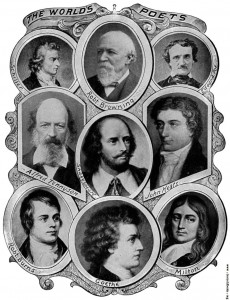Poetry Lesson Plan for High School: How to Annotate a Poem

Mastering the Technique

This is Emily Dickinson. My 10th grade English teacher loved Emily Dickinson. I did not. I do now. Here are some analyses of Emily Dickinson poems that I wrote. May my 10th grade English teacher rest in peace.
(Hey, here’s a chart for teaching sound devices in poetry so your students will have an easy way to organize their discoveries. It’s ready to use now!)
I thought I knew how to analyze a poem, but it wasn’t until I learned how to annotate a poem that I truly mastered it. And it wasn’t until I taught students how to annotate a poem that I really learned how to do both. I owe it all to this poetry lesson plan.
- Choose a short poem (15-20 lines). Copy it onto a half-slice of paper and use the other half for writing an analysis.
- Write the poem on the board.
- Read the poem aloud.
- Instruct students to identify the following elements and make notations: rhyme scheme, figurative language, images, symbols, sound devices (alliteration, consonance, assonance, rhythm, onomatopeia, off rhyme).
- Instruct students to circle any part of the poem that stands out, confuses them, or is important.
- Write questions in the margin; highlight unusual words; mark phrases that indicate the poem’s meaning.
- Determine the poem’s theme and draw arrows to the lines that support the theme.
Assume the Best

This is Langston Hughes. Check out an annotation and analysis of “What Happens to a Dream Deferred?” and “Dreams.”
Don’t assume students will find this activity boring. Most often, they are pleased they get to think through a poem without the pressure of being “right or wrong.” Encourage them to write whatever comes to mind. Use these poetry lesson plan procedures to get the most out of the assignment.
- Go over the instructions for annotating a poem
- Instruct students to annotate the poem they copied down. Give them five minutes to come up with as much as they can.
- Hand a white board marker to a student and instruct him or her to identify the rhyme scheme.
- Hand a marker to another student and have him or her identify figurative language.
- Choose a different student for each of the following: images, symbols, metaphors, similes, sound devices, and meaningful lines.
- Ask for volunteers to come up and add anything they wish to the board annotations. They may be shy at first. If so, throw the marker and choose the student it lands closest to.
- You may have anywhere from 1-5 students at the board at once while the remainder of the class continues writing on their own paper.
- Feel free to make a few annotations yourself to keep things rolling. It’s important to encourage students. Acknowledge all efforts with appreciation.
- Revel in the words of master poets.
Say hello to Robert Frost.
You’ll discover amazing things as you participate in the process. For example, I discovered that
- Robert Frost’s “Stopping by Woods on a Snowy Evening” makes sense forwards and backwards.
- William Wordsworth’s “Daffodils” is about the subconscious connection poets in nature make with the Universe/God.
- Langston Hughes uses peaceful images of rot to set the reader up for an explosion in “What Happens to a Dream Deferred?”.
- John Keats emphasizes that our best is good enough even if it isn’t good in “Ode on a Grecian Urn.”
Write the Poetry Analysis
Once the annotations are complete, it’s time to write the analysis. Remind students that an analysis consists of facts and commentaries. It is not a summary, a listing of facts, or random, unsubstantiated conjecture. Use the following outline to help students:
I. Topic sentence stating the title of the poem, the author, and the poem’s theme.
A. Evidence #1: Identify an important line, poetic device, rhyme scheme, etc.
- Analysis/Interpretation #1: Explain how the evidence supports the designated theme.
- Analysis/Interpretation #2: Explain how the evidence supports the designated theme.
B. Evidence #2: Identify an important line, poetic devices, rhyme scheme.
- Analysis/Interpretation #1: Explain how the evidence supports the designated theme.
- Analysis/Interpretation #2: Explain how the evidence supports the designated theme.
C. Concluding Sentence
Common Core Standards
This poetry lesson plan satisfies the following common core standards.
- RL.9-10.1 Cite strong and thorough textual evidence to support analysis of what the text says explicitly as well as inferences drawn from the text. W.9-10.1 Write arguments to support claims in an analysis of substantive topics or texts, using valid reasoning and relevant and sufficient evidence.
- RL.9-10.2 Determine a theme or central idea of a text and analyze in detail its development over the course of the text, including how it emerges and is shaped and refined by specific details; provide an objective summary of the text.
- RL.9-10.4 Determine the meaning of words and phrases as they are used in the text, including figurative and connotative meanings; analyze the cumulative impact of specific word choices on meaning and tone (e.g., how the language evokes a sense of time and place; how it sets a formal or informal tone).
- RL.9-10.10 By the end of grade 9, read and comprehend literature, including stories, dramas, and poems, in the grades 9-10 text complexity band proficiently, with scaffolding as needed at the high end of the range. By the end of grade 10, read and comprehend literature, including stories, dramas, and poems, at the high end of the grades 9-10 text complexity band independently and proficiently.
- W.9-10.1a Introduce precise claim(s), distinguish the claim(s) from alternate or opposing claims, and create an organization that establishes clear relationships among claim(s), counterclaims, reasons, and evidence.
- W.9-10.2b Develop the topic with well-chosen, relevant, and sufficient facts, extended definitions, concrete details, quotations, or other information and examples appropriate to the audience’s knowledge of the topic. W.9-10.2a Introduce a topic; organize complex ideas, concepts, and information to make important connections and distinctions; include formatting (e.g., headings); grap
- W.9-10.5 Develop and strengthen writing as needed by planning, revising, editing, rewriting, or trying a new approach, focusing on addressing what is most significant for a specific purpose and audience. (Editing for conventions should demonstrate command of L.9-10.1-3.) hics (e.g., figures, tables); and multimedia when useful to aiding comprehension.
- W.9-10.4 Produce clear and coherent writing in which the development, organization, and style are appropriate to task, purpose, and audience.
- L.9-10.1 Demonstrate command of the conventions of standard English grammar and usage when writing or speaking.
Last Updated on October 20, 2017 by Trenton Lorcher
Share This: